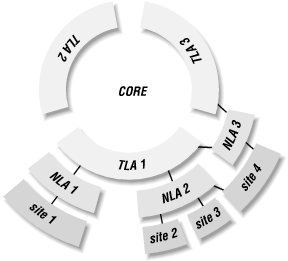 |  |
10.14. The ABCs of IPv6 Addressing
Before we cover the next two topics, which include how domain names map to IPv6 addresses and vice versa, we'd better describe the representation and structure of IPv6 addresses. As you probably know, IPv6 addresses are 128 bits long. The preferred representation of an IPv6 address is eight groups of as many as four hexadecimal digits, separated by colons; for example:
The first group of hex digits (0123, in this example) represents the most significant (or highest order) four bits of the address.0123:4567:89ab:cdef:0123:4567:89ab:cdef
Groups of digits that begin with one or more zeros don't need to be padded to four places, so you can also write the previous address as:
Each group must contain at least one digit, though, unless you're using the :: notation. The :: notation allows you to compress sequential groups of zeros. This comes in handy when you're specifying just an IPv6 prefix. For example:123:4567:89ab:cdef:123:4567:89ab:cdef
specifies the first 32 bits of an IPv6 address as dead:beef and the remaining 96 as zeros.dead:beef::
You can also use :: at the beginning of an IPv6 address to specify a suffix. For example, the IPv6 loopback address is commonly written as:
or 127 zeros followed by a single one. You can even use :: in the middle of an address as a shorthand for contiguous groups of zeros:::1
You can use the :: shorthand only once in an address, since more than one could be ambiguous.dead:beef::1
IPv6 prefixes are specified in a format similar to IPv4's CIDR notation. As many bits of the prefix as are significant are expressed in the standard IPv6 notation, followed by a slash and a decimal count of exactly how many significant bits there are. So the following three prefix specifications are equivalent (though obviously not equivalently terse):
IP Version 4 addresses are hierarchical, mirroring the nature of IPv4 networks: individual networks connect to Internet service providers, which in turn connect to other ISPs or to the core of the Internet. Each provider assigns a few bits of the overall 32-bit IP address: providers closer to the core of the Internet assign bits earlier in the address, and finally the administrator of the network assigns the remaining bits.dead:beef:0000:00f1:0000:0000:0000:0000/64 dead:beef::00f1:0:0:0:0/64 dead:beef:0:f1::/64
IPv6 was designed to accommodate a much larger Internet, so IPv6 addresses have even more levels of hierarchy. Each level corresponds to one of the levels of networks in an IPv6-based internet.
At the core of an IPv6 internet, there are Top-Level Aggregators , or TLAs. TLAs are networks that connect directly to the backbone of the internet and provide connectivity to Next-Level Aggregators , or NLAs. NLA networks connect site networks to an IPv6 internet. The whole arrangement is depicted in Figure 10-5.

Figure 10-5. The structure of an IPv6 internet
As with IPv4 networks, each of these organizations assigns certain bits of an IPv6 address. To help you picture the addressing hierarchy within IPv6, here's a diagram of the most common structure of an IPv6 address, as described in RFC 2374:
FP is the Format Prefix, the first three bits of the address, which determine the format of the rest of the address. The Format Prefix for this particular format, called (take a breath) the IPv6 Aggregatable Global Unicast Address Format, is 001. The next 13 bits identify the Top-Level Aggregator, followed by three reserved bits (set to zero), then 24 bits specifying the Next-Level Aggregator. The remaining bits are used by the site: the Site-Level Aggregator ID, or SLA ID,is basically like the subnet bits in an IPv4 address, and the Interface ID uniquely identifies a particular interface on the site's network.| 3| 13 | 8 | 24 | 16 | 64 bits | +--+-----+---+--------+--------+--------------------------------+ |FP| TLA |RES| NLA | SLA | Interface ID | | | ID | | ID | ID | | +--+-----+---+--------+--------+--------------------------------+
In this address format, each ID is assigned by the entity at the next level up in the hierarchy. For example, a single, top-level address registry assigns TLA IDs to the Top-Level Aggregators. TLAs, in turn, assign NLA IDs to their NLA customers, who assign SLA IDs to their customers. NLA IDs need only be unique within a TLA ID, just as SLA IDs need only be unique within a particular NLA ID.



